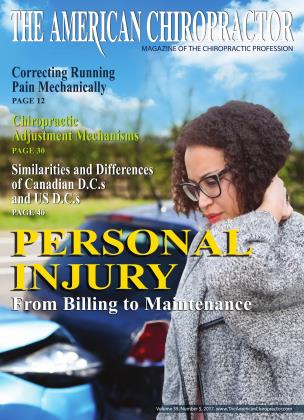Personal Injury Protection for Your Practice
FEATURE
Lisa Maciejewski
West, CMC, CMOM, MCS-P
For some doctors, taking on a personal injury (PI) case is like speculating in oil futures—it’s either going to be boom or bust. PI cases can represent a lucrative profit center for a chiropractor. Most auto PI cases involve mainly soft tissue injury, which is right in the chiropractor’s wheelhouse. So why do personal injury cases represent less than 5% of most practices? One of the main factors is a clinic’s failure to protect the money that is due to them.
The first thing any chiropractic office should know with respect to PI is whether they are practicing in a “fault” or “no-fault” state. No-fault insurance means that the patient’s automobile insurer will pay some or all of the medical bills and lost earnings if the patient gets into an accident, regardless of who was at fault. About a dozen states have “no-fault” car insurance laws: District ofColumbia, Florida, Hawaii, Kansas, Kentucky, Massachusetts, Michigan, Minnesota, New Jersey, New York, North Dakota, Pennsylvania, and Utah. (This list may not be complete at time of publication because no-fault laws change each year. Check with your state insurance board annually). Every state’s law is different. In some “no-fault” states, there is a limit to what benefits the automobile insurance company will pay; in others, there is no limit. In “no-fault” states, patients may sue the at-fault party for damages in excess of their medical and lost wage expenses, not covered under their personal injury protection (PIP) plan.
The good news about practicing in a no-fault state is that you can bill the patient’s own auto carrier, as services are rendered, and receive payment directly from the patient. You don’t have to wait until the case settles to receive reimbursement, and you should submit the claims as soon as possible. Many states have caps on medical payments per occurrence, so you may be competing with the hospital and other medical providers for the med pay money. Get your bills in as soon as possible.
In a “fault” state, things get a little muddy. If a patient is in an accident and the accident was not his or her fault, the patient may want to sue the at-fault party (the other driver) for payment of medical bills, repairs, and lost wages. This is called a thirdparty claim. The problem with this, from your standpoint, is that the patient does not own that policy; it belongs to the at-fault party, the carrier has no obligation to pay you directly because the patient cannot assign benefits. The at-fault carrier will deal directly with the patient (or an attorney, if the patient seeks legal counsel). Most of the time, the at-fault carrier will have the patient wait until all treatment is completed and all repair bills are in before settling with the patient on a fair amount of reimbursement. At that point, the carrier will pay the patient (or their attorney) a lump sum settlement, and you
"The first thing any chiropractic office should know with respect to PI is whether they are practicing in a “fault” or “no-fault” state."
will be at their mercy to pay you. You risk a total loss, unless you can protect that money. Some doctors will not defer payment, requiring the patient to pay out of pocket and be reimbursed by the third-party carrier on settlement.
If you defer payment, what can you do to strengthen your position? First, have a written financial policy that clearly states the patient’s responsibility for all unpaid amounts. Let patients know that they can file with their own auto carrier if they have PIP coverage. If the accident was not their fault, most carriers will not raise rates. If legal in your state, have the patient sign a doctor’s lien, which should be filed at your county courthouse. Look for other sources of revenue. You may consider filing for payment on the patient’s health insurance. Some patients have accidental policies that may cover some of the bills, i.e., AFLAC. Credit card companies provide a small accidental insurance plan that patients may not even be aware as part of their benefits. Depending on where the accident took place, they also may have coverage under their homeowner’s insurance.
Query the patient about these additional revenue sources. If an attorney is involved, require a letter of
protection (LOP) from the attorney. The LOP will state that the attorney guarantees payment of benefits on settlement. Be prepared to negotiate that settlement amount with the attorney’s office because they will almost always want to discount the bill. Have a “standard” discount that you will accept, and never let the discount take you lower than your Medicare rates.
^The good news about practicing in a no-fault state is that you can bill the patient’s own auto carrier, as services are rendered, and receive payment directly from the patient. J J
LisaMaciejewski-West, CMC, CMOM, MCS-P. With 35 years of experience in the chiropractic field, Lisa is the president owner of Gold Star Medical, offering professional billing, compliance, and consulting services. Lisa holds certifications in coding, management, and compliance. She speaks regularly at local and state
associations and for medical and chiropractic organizations nationwide. Lisa can be reached at goldstarmedical ayrisn.com or by phone 866-942-5655.
 View Full Issue
View Full Issue









